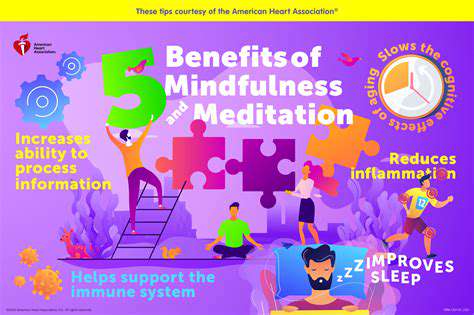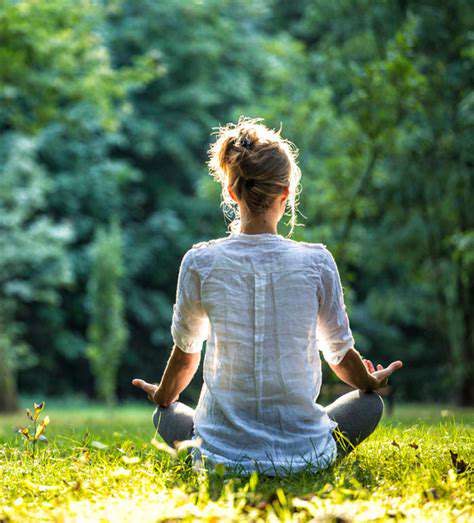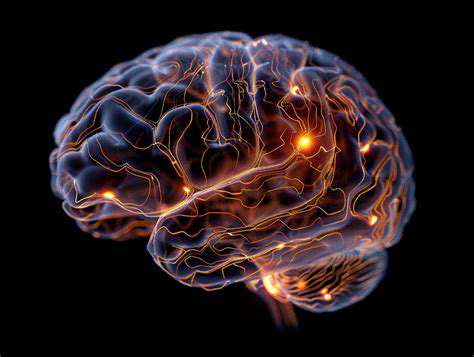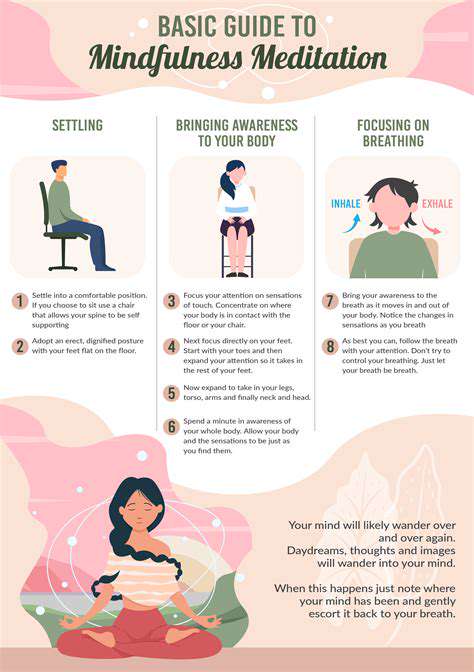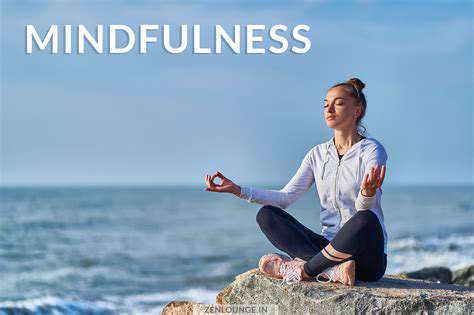Creating a Calming Environment for Mindfulness and Relaxation
The Importance of a Calming Environment
The Impact of Surroundings on Mental Well-being
The environment we inhabit has a profound effect on our mental state. A cluttered or chaotic space can lead to increased stress and anxiety, hindering our ability to focus and relax. A calming environment, conversely, promotes serenity and allows for better mindfulness practices.
Research has shown that natural elements, such as plants and natural light, can enhance our mood and productivity. Incorporating these elements into our spaces can create a restorative atmosphere that encourages relaxation.
Additionally, neutral colors and minimalist designs can reduce distractions and create a sense of balance. These choices align with the principles of mindfulness, allowing individuals to remain present in their surroundings.
It's essential to consider how sound impacts our environment, too. Soft music or nature sounds can create a soothing backdrop for relaxation. Conversely, loud noises can disrupt concentration and heighten feelings of stress.
Ultimately, cultivating a calming environment requires a mindful approach, where we intentionally choose elements that promote peace, clarity, and emotional well-being.
Creating a Sanctuary for Mindfulness
A sanctuary is a personal space dedicated to relaxation and mindfulness. This could be a corner of a room or an entire room designed specifically to support mental well-being. The key is to make it a reflection of your needs and preferences.
Begin by selecting a location that feels comfortable and inviting. This space should be free from distractions and anything that draws attention away from your practice. You might want to add soft cushions or a comfortable chair for seating.
Incorporating personal items like photographs or meaningful objects can enhance the feeling of security and warmth. These items can help ground you in the moment, boosting the effectiveness of your mindfulness practice.
Consider the sensory elements of your sanctuary, from the scents you choose to diffuse to the colors on your walls. Each element should contribute to a feeling of tranquility, making it easier to slip into a mindful state.
Finally, make it a habit to retreat to your sanctuary regularly. Consistent use of this space fosters a predictable routine that trains your mind to enter a state of calm and mindfulness more readily.
Incorporating Nature into Your Space
Nature is a powerful ally in creating a calming environment. Research indicates that spending time in nature can reduce stress levels and promote overall well-being. Therefore, incorporating natural elements into your living space can be beneficial.
Indoor plants are an excellent way to bring a bit of nature indoors. They not only purify the air but also enhance the aesthetic appeal of your space. Consider low-maintenance plants like succulents or snake plants if you have limited time for care.
Natural light is another essential aspect to consider. Whenever possible, maximize sunlight in your space by using sheer curtains or strategically placing mirrors to reflect light. Exposure to natural light can significantly boost your mood and energy levels.
Incorporating natural materials such as wood, stone, or bamboo in your decor can also create a sense of connection to the earth. These textures add warmth and invite a sense of grounding into your space.
Lastly, make time for outdoor experiences, whether it’s a simple walk in your neighborhood or a visit to a local park. These moments reinforce the natural elements you've integrated into your home, promoting a holistic approach to mindfulness and relaxation.
The Role of Scent in Creating Calm
Often overlooked, scent plays a crucial role in setting the mood within our environments. Aromas can evoke powerful emotional responses and influence our state of mind. Therefore, selecting the right scents can enhance a calming atmosphere.
Aromatherapy is a practical way to introduce soothing scents to your space. Essential oils like lavender, chamomile, and sandalwood are renowned for their calming properties. Diffusers or simple oil application can help to purify the air and carry these aromas throughout your space.
Candles also provide an excellent source of calming scents. Beyond their fragrance, they create a soft, inviting glow that promotes relaxation. Opt for unscented options with calming colors to enhance the peaceful atmosphere.
Consider the emotional connection you have with certain scents. For example, fresh linen may evoke feelings of cleanliness, while ocean breeze can remind you of summer days. Incorporating these scents can amplify feelings of comfort and relaxation.
Lastly, experiment with seasonal scents to keep your environment fresh and engaging. The smells of autumn spices or spring florals can renew your mindfulness practice, making the experience even more rewarding.
Mindful Practices to Enhance Relaxation
Creating a calming environment is only one piece of the puzzle. Engaging in mindful practices can help solidify that tranquility and bring about a deep sense of relaxation. One popular method is meditation, which clears the mind and promotes awareness.
Mindful breathing exercises can also be beneficial. Focusing on your breath can ground you in the present moment, helping to reduce anxiety and improve your emotional regulation. Even a few minutes of this daily practice can reap significant benefits.
Journaling is another excellent method for fostering mindfulness. Writing about your thoughts and feelings encourages self-reflection and helps you process emotions. This practice can create a deeper understanding of your inner landscape, which is essential for relaxation.
Incorporating gentle yoga or stretching can also enhance the calming effects of your environment. Movements that focus on breathing and connection to the body can further alleviate tension and promote physical relaxation.
Finally, consider integrating mindful eating into your practices. Taking time to fully engage with your meals, savoring each bite, can be a great way to cultivate mindfulness and appreciation for the present moment.
Elements of a Calming Space
Color Palette and Lighting
Choosing a soothing color palette is essential for creating a calming environment. Soft, muted colors such as pastel shades or earth tones can foster tranquility and promote relaxation. These colors encourage a sense of peace and help to reduce anxiety levels.
In addition to color, lighting plays a critical role in setting the mood. Natural light is ideal, as it can create a warm and inviting atmosphere. If natural light is limited, consider using soft, warm artificial lights or strategically placed lamps to create a cozy ambiance.
It's also beneficial to incorporate adjustable lighting options. Dimmable lights allow you to tailor the brightness based on the time of day or the specific activity you are engaged in, further enhancing the calming effect of the space.
Incorporating Nature
Bringing elements of nature indoors can significantly elevate the calming atmosphere. Houseplants not only purify the air but also add a splash of greenery that is visually soothing. Consider easy-to-maintain plants like succulents or peace lilies to add life to your space without demanding too much care.
Natural materials can also contribute to a serene environment. Opt for wooden furnishings, stone accents, and textiles made from natural fibers. These materials create a connection to the earth, which can be grounding and comforting.
Additionally, incorporating water features such as small fountains or aquariums can create a tranquil auditory backdrop. The sound of flowing water is known to be calming and can help drown out distractions, allowing for deeper mindfulness practices.
Sound and Scent
Sound is a powerful component of any calming environment. Consider incorporating soothing background music or nature sounds, such as ocean waves or gentle rain. These auditory elements can enhance relaxation and help you focus during mindfulness activities.
Aromatherapy is another effective way to promote relaxation. Use essential oils such as lavender, chamomile, or sandalwood in a diffuser or as candles to create a soothing scent that fills the space. Scents can evoke emotions and memories, so choose aromas that resonate with you personally for maximum benefit.
Creating a sound and scentscape that you find enjoyable is key. You might experiment with different soundscapes or fragrances until you discover the combination that helps you achieve the best state of relaxation.
Creating Comfortable Spaces
Furniture selection plays a vital role in establishing a calming environment. Opt for comfortable seating options with supportive cushions that invite relaxation, such as oversized chairs or bean bags. This encourages you to settle in and take time for yourself.
Incorporate soft textiles such as plush blankets and pillows into your space. These textiles not only add comfort but also create a sense of coziness that invites you to unwind. Layering textures can also make the environment feel more inviting and warm.
Lastly, consider the layout of the space. Ensure that it allows for easy movement and encourages a flow that feels natural. A clutter-free environment can help minimize distractions, while well-placed furniture can create intimate corners for mindfulness practices like meditation or journaling.
1. Color Palette and Lighting
1.1 The Impact of Color Psychology
Color psychology plays a critical role in how we perceive our environment. Different colors can evoke different emotions and influence our state of mind. For instance, soft blues and greens can create a sense of tranquility, while warm yellows can inspire feelings of happiness and energy.
When designing a calming environment, it's essential to choose a color palette that promotes relaxation. Cool tones often mirror the soothing properties of nature, helping to lower stress levels and enhance focus.
Additionally, incorporating neutral colors can provide a grounding effect, offering balance and harmony within the space. The right mix of colors can transform a room into a haven for mindfulness practices.
It's also beneficial to consider the cultural aspects of color perception, as these can vary widely across different societies. Being mindful of these differences ensures a more inclusive approach to creating a soothing atmosphere.
Lastly, the colors chosen should extend to decor items such as cushions, curtains, and artwork to maintain a cohesive and calming aesthetic throughout the space.
1.2 The Role of Natural and Artificial Light
Lighting is another essential element that contributes significantly to the ambiance of a calming environment. Natural light enhances mood, supports circadian rhythms, and can make spaces feel more open and inviting. Maximize natural light by using sheer window treatments and positioning furniture to avoid blocking any sunlight.
During cloudy days or in the evening, artificial lighting should aim to replicate the warmth of natural light. Consider using soft white or warm colored bulbs that can provide a cozy atmosphere, avoiding harsh fluorescent lights that can feel sterile and harsh.
Incorporating layers of light adds depth to a room. This can include ambient lighting for overall illumination, task lighting for specific activities, and accent lighting to highlight certain features of the space. Dimmers are also a great addition, allowing for adjustable lighting based on the time of day or activity.
Furthermore, including elements like candles or salt lamps can introduce soft glow and enhance relaxation. The flickering of candlelight has been shown to have a calming effect, making it an excellent addition to a mindfulness space.
Lastly, be mindful of how light changes throughout the day and consider setting up your space to adapt to these changes. This flexibility can help maintain a soothing environment that supports your mindfulness practices at all times.
2. Nature and Greenery
Benefits of Incorporating Nature
Integrating nature into your environment has been shown to significantly enhance your mental well-being. Exposure to natural elements helps reduce stress levels, lowers blood pressure, and improves mood. Studies suggest that simply looking at plants or nature images can result in immediate improvements in mood and cognitive function.
Being in natural surroundings can trigger a sense of tranquility, promoting a state of mindfulness. This effect can be particularly beneficial during meditation or relaxation practices, as nature has a way of grounding us and connecting us to the present moment.
Furthermore, nature can serve as a wonderful distraction from the pressures of daily life. It encourages a break from digital distractions and invites a slower, more contemplative pace that can foster creativity and relaxation.
Choosing the Right Plants
When selecting plants for your calming environment, consider species that are known for their air-purifying qualities. Plants like peace lilies, spider plants, and snake plants not only enhance the aesthetic of your space but also contribute to cleaner indoor air, which can positively affect your mood and health.
Low-maintenance plants such as succulents or pothos are ideal for those who may lack a green thumb. They require minimal care while still providing the calming benefits of greenery. Additionally, consider incorporating fragrant plants such as lavender or jasmine, which can evoke a relaxing atmosphere through their soothing scents.
Ultimately, choose plants that resonate with you personally. The emotional connection to the greenery you select can enhance your mindfulness practice, making the space feel more inviting and tailored to your needs.
Enhancing Spaces with Natural Elements
Incorporating natural materials into your decor can further enhance a calming environment. Wood furnishings, stone accents, and natural fabrics like cotton or linen can create a warm and inviting atmosphere. These materials not only look aesthetically pleasing but also help in grounding the environment, making it a perfect backdrop for mindfulness practices.
Consider using natural light to your advantage. Large windows or strategically placed mirrors can amplify the amount of sunlight in a room, which has been proven to uplift mood and energize the mind. The inclusion of water features, such as a small fountain, can add a tranquil auditory component that further promotes relaxation.
Creating additional spaces for meditation or quiet reflection that incorporate natural elements can enhance your mindfulness practice. A corner with cushions and natural light or an outdoor space filled with plants can encourage peaceful contemplation.
Creating an Outdoor Mindfulness Space
Designing an outdoor area for mindfulness can greatly enhance your relaxation experience. Consider a small garden, patio, or balcony where you can be surrounded by greenery and fresh air. This space should be free from distractions and should promote peace and tranquility.
Incorporate seating that allows you to comfortably immerse yourself in nature, such as a hammock, cozy chair, or even a meditation bench. Enhance the space with aromatic plants or herbs, as they can stimulate your senses and deepen your mindfulness practice.
Interaction with the outdoor environment can be a mindful exercise in itself. Take the time to notice the sounds, scents, and feelings of your surroundings, furthering your connection to nature and enhancing your ability to be present in the moment.
Mindfulness Activities to Practice with Nature
Engaging in mindfulness activities outdoors can amplify the benefits you receive from both nature and mindfulness practices. Activities such as walking or hiking in a natural setting can provide not just physical health benefits but also cultivate a deeper appreciation for the outdoors.
Practicing mindfulness meditation in a natural space can be incredibly powerful. Sit or lie down in a comfortable position and focus on your breath or the sensations of your surroundings—the sounds of birds, the rustle of leaves, or the feeling of the sun on your skin.
Additionally, nature journaling can be a wonderful way to engage with your environment mindfully. Take time to observe nature and jot down thoughts, sketches, or feelings that arise, allowing for reflection and connection to the natural world.
3. Sound and Silence

Understanding the Role of Sound
Sound plays a crucial role in shaping our environment and can significantly influence our state of mind. The right sounds can enhance relaxation, while unwanted noise can lead to stress and distraction. By carefully curating the auditory backdrop of your space, you can create an atmosphere conducive to mindfulness.
Natural sounds, such as flowing water or gentle birdsong, can evoke a sense of serenity. Incorporating these elements into your environment can help foster a deeper connection to the present moment. Consider using sound machines or nature sound playlists to maintain a peaceful ambiance.
The Power of Silence
Silence can be a powerful tool for mindfulness and reflection. In a world filled with constant noise, carving out time for silence allows for introspection and a greater awareness of one’s thoughts. Embracing silence can foster deeper relaxation and mental clarity.
Create quiet zones in your environment where you can retreat for mindfulness practices. This space should be free from distractions and filled with a sense of peace, allowing you when needed to step away from the noise of daily life.
Balancing Sound and Silence
Striking a balance between sound and silence is essential for creating a calming environment. Utilizing elements like soft instrumental music during mindful sessions, followed by periods of silence, can enhance the overall experience. This shifting dynamic can help ground your practice and enhance your focus.
Consider designing activities that incorporate both aspects, such as transitioning from guided meditation with soothing sounds to moments of complete silence. This balance not only aids relaxation but also heightens your awareness and present-moment experience.
4. Personalization and Comfort
Understanding Personal Preferences
Creating a calming environment is deeply rooted in personal preference. Each individual has their own unique tastes and preferences when it comes to colors, textures, and scents. For example, some people may find that soft pastels promote a sense of tranquility, while others might prefer deeper, richer hues. Understanding what resonates with you personally is crucial in crafting a space that feels comfortable and inviting.
Moreover, the choice of materials can also impact the overall comfort level of a space. Items like plush cushions, soft throws, and natural wood elements can create a warm ambiance. Assessing what materials bring you comfort can be an enjoyable part of the personalization process.
Don’t forget to consider sensory preferences as well. Certain aromas can evoke memories and feelings of peace. Candles, essential oils, or even fresh flowers can enhance your mindfulness practice if they align with your personal tastes.
Adapting the Space for Different Activities
Another important aspect of personalization is adapting your environment to suit various activities. Whether you’re meditating, journaling, or simply unwinding, it’s beneficial to tailor your space accordingly. For instance, a cozy reading corner might require good lighting and a comfortable chair, whereas a meditation area may be best suited with minimal distractions.
Making these adjustments doesn’t have to be cumbersome. Simple changes, like rearranging furniture or adding temporary decor, can significantly influence the atmosphere and help create a space that reflects what you need in the moment. It’s all about being flexible and responding to your current emotional or mental state.
Moreover, including elements that inspire creativity can also be a form of personalization. Think art supplies, musical instruments, or even a place to display your favorite books. By incorporating aspects that speak to your interests, you enrich your environment and make it more engaging.
The Importance of Comfort and Safety
At its core, a calming environment must prioritize comfort and feelings of safety. A space that feels secure allows for deeper relaxation and mindfulness practice. Therefore, invest in comfortable seating options and ensure that the layout of the room promotes a feeling of openness rather than constriction.
Additionally, decluttering your space can help foster a sense of calm. A tidy environment often leads to a clearer mind and enhances the ability to focus on the present moment. Regularly assessing what items are essential and which can be removed from your mindfulness space is important for maintaining this serenity.
Lastly, consider incorporating personal items that evoke positive emotions, such as photos of loved ones or souvenirs from meaningful experiences. These small touches can elevate your sense of belonging and comfort, enriching your mindfulness experience further.
5. Decluttering and Organization

Understanding the Impact of Clutter
Clutter can significantly affect our mental health and overall well-being. A disorganized space often leads to increased stress and anxiety levels. Creating a soothing environment starts with recognizing how our surroundings can influence our mind and emotions.
When our living spaces are cluttered, it can create a sense of chaos that distracts us from mindfulness practices. By simplifying our environments, we open the door to tranquility and focus. It’s essential to be aware of how a chaotic space can impact our ability to relax and be present.
Thus, investing time in decluttering our spaces fosters not only physical peace but also mental clarity. When we feel relaxed and organized, we create a better foundation for mindfulness practices to flourish.
Practical Steps for Decluttering
To begin decluttering, consider tackling one room or area at a time to prevent feeling overwhelmed. Breaking tasks into smaller, manageable steps allows for greater focus and effectiveness. Start with items that no longer serve a purpose and decide whether to donate, recycle, or discard them.
Develop a systematic approach by categorizing items into keep, discard, and donate sections. This method helps sharpen decision-making skills and promotes a sense of accomplishment as you see your space transforming into a calmer environment. The goal is to create a space where you feel at ease, free from distractions.
Moreover, maintaining this organization requires regular check-ins and adjustments. Make it a habit to regularly assess your belongings and ensure your space remains clutter-free, promoting continuity in relaxation and mindfulness practices.
Creating Mindfulness Zones
Once decluttering is complete, create dedicated mindfulness zones within your space. These zones should be equipped with elements that induce calmness, such as comfortable seating, soft lighting, and soothing decor. The intention is to cultivate an inviting area that inspires mindfulness and relaxation.
Consider incorporating natural elements. Plants, stones, or water features can enhance the ambiance of your mindfulness zones, helping to ground you in the present. Integrating sensory elements fosters a deeper connection to your surroundings and enhances the overall experience of mindfulness.
Finally, personalize your space with items that promote joy and relaxation, like favorite books, calming scents, or soothing music. By nurturing these zones, you create a ritual space that invites calmness and encourages regular practice of mindfulness in your life.
